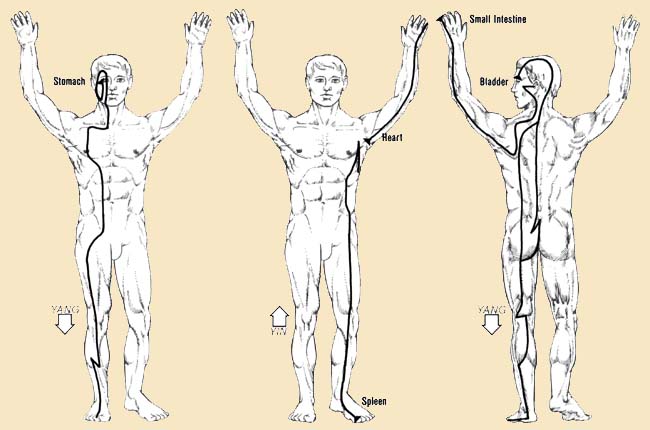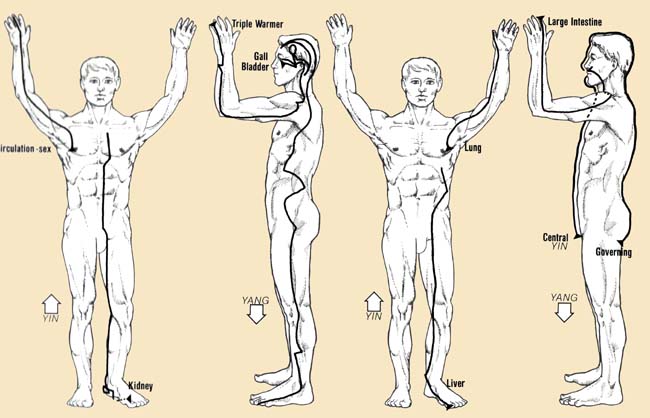
RAW4: Info — Chinese Meridian System
AUDIO: (No audio)
Response Options:• Close this extra window • (browser back arrow greyed out) when readyNotes:Meridian system

|
Notes (continued):IntroductionTraditional Chinese Medicine (TCM) dates from three thousand years ago. The use of acupuncture dates from over two thousand years ago.Reach and Withdraw is not part of TCM at all, and there is no attempt in this RAW4 module to make use of any of the traditional Chinese methodologies. If you are interested in TCM, there is plenty of information online or in books. There are 12 main meridians, and 8 "extraordinary" ones. The main ones are the heart, small intestine, bladder, kidney, circulation-sex (pericardium), triple-warmer (triple-heater, triple-burner), gallbladder, liver, lung, large intestine, stomach, and spleen. Of the extraordinary ones, two are of major importance: the governing vessel and the central (conception) one. Meridians exist in pairsThe 12 main meridians exist as pairs, one on each side of the body. Although one may speak of "the heart meridian," remember that it has two branches.Meridians are same level as aura bodies and chakrasThe meridians are part of the subtle energy structure of a person, and belong to the same "dimension" as the aura bodies and chakras. They are channels for moving subtle energy (life force, chi) around the whole person. Like the chakras, consider that a single meridian channel and its acupuncture points has its existence in all seven aura bodies.Acupuncture points are small energy vorticesA meridian might be shown as a line, usually as a series of acupuncture points. These points represent small energy vortices, counterparts of the large main chakras, where these small vortices intersect with the skin. The vortices have their tips in a channel, which is the actual meridian (not the points).The 12 main meridians form one long pathThe meridians are all interconnected to form one long channel, in the sequence as listed above. You can see this in the diagrams. You can trace along the stomach meridian ending in the foot, then along the spleen meridan going from the foot to the armpit, then the heart meridian from the armpit to the little finger and so on.ImbalancesVarious blockages and imbalances such as being over-charged and under-charged occur with the meridians, which can adversely affect a person's well-being. These can be addressed and remedied in various therapies. The purpose of RAW4 is to increase one's familiarity with one's total anatomy and not so much to remedy any shortcomings, although such may very well occur as a result of the repeated Reaching and Withdrawing.Central and governing meridiansThe main points of these two correspond to the major chakras, the central (conception) vessel/meridian in the front of the body and the governing vessel/meridian at the back. These two connect with the 12 main meridians. The meridians belong to the Chinese system, the chakras a Hindu one.Reach & Withdraw on a meridianWhen reaching to a meridian, you may find it helpful to use your physical body hand(s) to trace the surface line of the meridian while imagining yourghost hand(s)reaching into your physical body and tracing the actual meridian deep inside. If you can, continue tracing the path of the meridian deep inside the body until it connects up with the next meridian there. You don't have to trace the entire meridian with each command, but just do a bit at a time. R & W on an acupuncture pointWhen reaching to an acupuncture point, you may find it helpful to use your physical body hand(s) to touch the appropriate point(s) on the skin, while imagining the energy vortex there. But remember you are not doing Reach & Withdraw on the actual skin. |